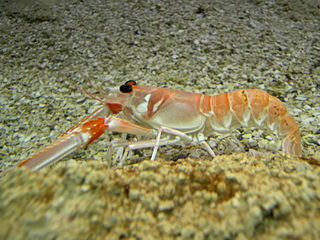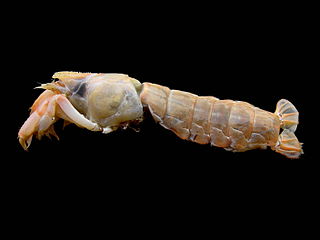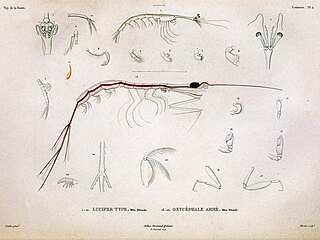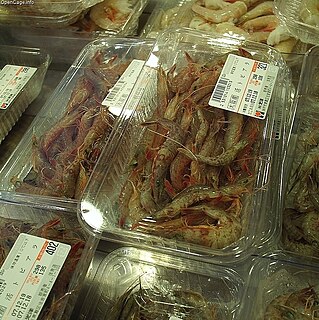
Tabgha is an area situated on the north-western shore of the Sea of Galilee in Israel. It is traditionally accepted as the place of the miracle of the multiplication of the loaves and fishes and the fourth resurrection appearance of Jesus after his Crucifixion. Between the Late Muslim period and 1948, it was the site of a Palestinian Arab village.

The Stenopodidea or boxer shrimps are a small group of decapod crustaceans. Often confused with shrimp or prawns, they are neither, but belong in a group closer to the reptant decapods, such as lobsters and crabs. They can be easily recognized by their third pereiopod, which is greatly enlarged, while for lobsters and crabs, it is the first pereiopod that is much bigger than the others. There are 71 extant species currently recognized, divided into 12 genera. Three fossil species are also recognized, each belonging to a separate genus. The earliest fossil assigned to the Stenopodidea is Devonostenopus pennsylvaniensis from the Devonian. Until D. pennsylvaniensis was discovered, the oldest known member of the group was Jilinicaris chinensis from the Late Cretaceous.

Nephrops is a genus of lobsters comprising a single extant species, Nephrops norvegicus, and several fossil species. It was erected by William Elford Leach in 1814, to accommodate N. norvegicus alone, which had previously been placed in genera such as Cancer, Astacus or Homarus. Nephrops means "kidney eye" and refers to the shape of the animal's compound eye.

Thalassinidea is a former infraorder of decapod crustaceans that live in burrows in muddy bottoms of the world's oceans. In Australian English, the littoral thalassinidean Trypaea australiensis is referred to as the yabby, frequently used as bait for estuarine fishing; elsewhere, however, they are poorly known, and as such have few vernacular names, "mud lobster" and "ghost shrimp" counting among them. The burrows made by thalassinideans are frequently preserved, and the fossil record of thalassinideans reaches back to the late Jurassic.

The Cape lobster, Homarinus capensis, is a species of small lobster that lives off the coast of South Africa, from Dassen Island to Haga Haga. Only a few dozen specimens are known, mostly regurgitated by reef-dwelling fish. It lives in rocky reefs, and is thought to lay large eggs that have a short larval phase, or that hatch directly as a juvenile. The species grows to a total length of 10 cm (3.9 in), and resembles a small European or American lobster; it was previously included in the same genus, Homarus, although it is not very closely related to those species, and is now considered to form a separate, monotypic genus – Homarinus. Its closest relatives are the genera Thymops and Thymopides.

Lucifer is a little-known and degenerate genus of prawns, the type genus of the family Luciferidae. Lucifer has a long body, but many fewer appendages than other prawns, with only three pairs of pereiopods remaining, all without claws. It also bears no gills. The females, uniquely among prawns, carry the fertilised eggs on her pleopods until they are ready to hatch. This parallels the development of a similar system in pleocyemates, although the attachment is less strong in Lucifer. The length of the eye-stalks and the form of the petasma are used in distinguishing the eight species from each other.
Physetocaris is a monotypic genus of caridean shrimp, containing a single species, Physetocaris microphthalma.

The rusty crayfish is a large, aggressive species of freshwater crayfish which is native to the United States, in the Ohio River Basin in parts of Ohio, Kentucky, and Indiana. Its range is rapidly expanding across much of eastern North America, displacing native crayfishes in the process. The rusty crayfish was first captured in Illinois in 1973, and has been collected at over 20 locations in the northern portion of the state. In 2005, F. rusticus was found for the first time west of the Continental Divide, in the John Day River, Oregon, which runs into the Columbia River.
Cryphiops caementarius is a South American freshwater shrimp.
Barbouria is a genus of shrimp in the family Barbouriidae, comprising two species.

Palaemon serratus, also called the common prawn, is a species of shrimp found in the Atlantic Ocean from Denmark to Mauritania, and in the Mediterranean Sea and Black Sea.
Nanogalathea raymondi is a species of squat lobster from the Bay of Bengal. It is the only species in the genus Nanogalathea. It can be distinguished from other squat lobsters by the lack of any teeth along the edge of the rostrum. The specific epithet raymondi commemorates the carcinologist Raymond B. Manning.

Heterocarpus is a genus of deep-sea shrimp, mainly of tropical areas all over the world.

Oscillaria is a genus of filamentous diatoms.

Trachysalambria curvirostris is a species of prawn that lives in shallow waters of the Indo-West Pacific. It is one of the most important species targeted by prawn fishery, with annual harvests of more than 300,000 t, mostly landed in China.

Trachysalambria is a genus of prawns, containing ten species. It was erected in 1934 by Martin Burkenroad, as a subgenus of Trachypenaeus, with T. curvirostris as its type species. That subgenus was elevated to the rank of genus in 1997 by Isabel Pérez Farfante and Brian Kensley. The ten species are:

Albunea carabus is a rare species of "sand crab" or "mole crab" in the genus Albunea. It lives in shallow, turbulent waters in sandy areas of the tropical eastern Atlantic Ocean and the Mediterranean Sea.

Typhlocaris galilea is a species of troglobitic shrimp in the genus Typhlocaris, and is endemic to one pool and spring that feeds it, at Tabgha in Israel. The species is critically endangered and a conservation programme has begun.

Typhlocaris ayyaloni is a species of troglobitic shrimp in the family Typhlocarididae.














